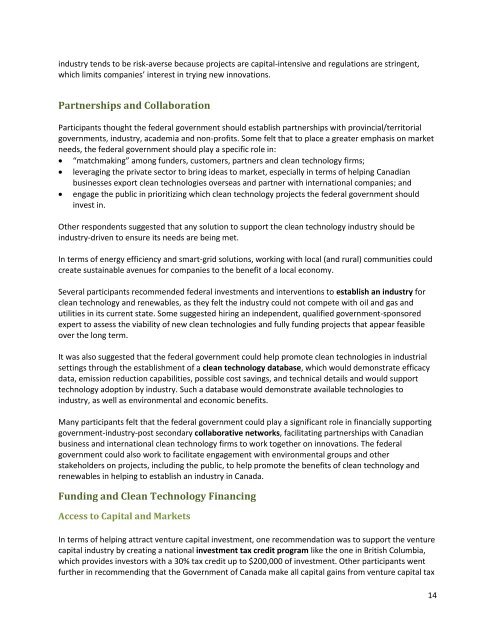LetsTalkCleanResources.ca
NGOQ307nOGf
NGOQ307nOGf
Create successful ePaper yourself
Turn your PDF publications into a flip-book with our unique Google optimized e-Paper software.
industry tends to be risk-averse be<strong>ca</strong>use projects are <strong>ca</strong>pital-intensive and regulations are stringent,<br />
which limits companies’ interest in trying new innovations.<br />
Partnerships and Collaboration<br />
Participants thought the federal government should establish partnerships with provincial/territorial<br />
governments, industry, a<strong>ca</strong>demia and non-profits. Some felt that to place a greater emphasis on market<br />
needs, the federal government should play a specific role in:<br />
“matchmaking” among funders, customers, partners and clean technology firms;<br />
leveraging the private sector to bring ideas to market, especially in terms of helping Canadian<br />
businesses export clean technologies overseas and partner with international companies; and<br />
engage the public in prioritizing which clean technology projects the federal government should<br />
invest in.<br />
Other respondents suggested that any solution to support the clean technology industry should be<br />
industry-driven to ensure its needs are being met.<br />
In terms of energy efficiency and smart-grid solutions, working with lo<strong>ca</strong>l (and rural) communities could<br />
create sustainable avenues for companies to the benefit of a lo<strong>ca</strong>l economy.<br />
Several participants recommended federal investments and interventions to establish an industry for<br />
clean technology and renewables, as they felt the industry could not compete with oil and gas and<br />
utilities in its current state. Some suggested hiring an independent, qualified government-sponsored<br />
expert to assess the viability of new clean technologies and fully funding projects that appear feasible<br />
over the long term.<br />
It was also suggested that the federal government could help promote clean technologies in industrial<br />
settings through the establishment of a clean technology database, which would demonstrate effi<strong>ca</strong>cy<br />
data, emission reduction <strong>ca</strong>pabilities, possible cost savings, and techni<strong>ca</strong>l details and would support<br />
technology adoption by industry. Such a database would demonstrate available technologies to<br />
industry, as well as environmental and economic benefits.<br />
Many participants felt that the federal government could play a signifi<strong>ca</strong>nt role in financially supporting<br />
government-industry-post secondary collaborative networks, facilitating partnerships with Canadian<br />
business and international clean technology firms to work together on innovations. The federal<br />
government could also work to facilitate engagement with environmental groups and other<br />
stakeholders on projects, including the public, to help promote the benefits of clean technology and<br />
renewables in helping to establish an industry in Canada.<br />
Funding and Clean Technology Financing<br />
Access to Capital and Markets<br />
In terms of helping attract venture <strong>ca</strong>pital investment, one recommendation was to support the venture<br />
<strong>ca</strong>pital industry by creating a national investment tax credit program like the one in British Columbia,<br />
which provides investors with a 30% tax credit up to $200,000 of investment. Other participants went<br />
further in recommending that the Government of Canada make all <strong>ca</strong>pital gains from venture <strong>ca</strong>pital tax<br />
14


